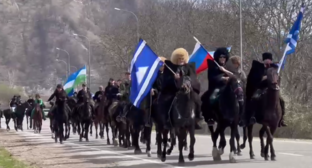02 June 2003, 18:00
Shakhsevens
Nation in the north-west of Iran (Eastern Azerbaijan and the Mugan steppe) and in the south of Azerbaijan. They divide into two territorial groups - Ardebil and Meshkin. They are close to Azerbaijanians and sometimes are considered their sub-ethnic group. Their population in Iran is 270 thousand people; there?s no data on their number in Azerbaijan (in the USSR during the census they were registered as Azerbaijanias). They belong to the upper Asian version of the Balkan-Caucasus race of the big European race. They speak the eastern (mugan) dialects of Azerbaijanian language. Religious Shakhsevens are moslems-sunnites.
In the end of the 16th century there took place the uniting of Shakhseven tribes when shakh?s guards were taken from the different Turk tribes (Azerbaijanian ?shakhisevan? - ?those who love shakh?).
Traditional occupation - nomadic cattle-breeding (sheep, cattle as draught power, camels and horses), in summer - in Sebelen mountains, in winter - in Murgan steppe. Since the end of the 19th century they started to switch to settled farming.
Traditional dwelling - tents.
Traditional male costume - white or blue shirt with a belt, brown broadcloth trousers, cherkeska, sheepskin papakha, boots. In winter they wear sheepskin coats with long sleeves. They shave their heads leaving locks on the temples and wear beards. Female costume - blue shirt, trousers, arkhaluk, blue veil, wool socks, boots, golden and silver decorations. They cover heads with kerchiefs.
Traditional food - pilav, soups, mutton, milk products.
Shakhsevens retained their tribal division and some pre-Moslem customs (including the burial rites).





Комментирование через Кавказский узел